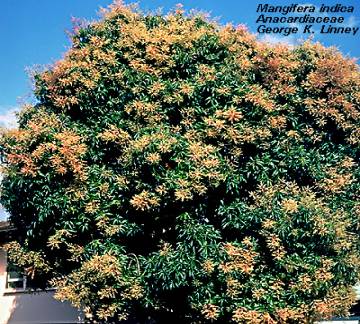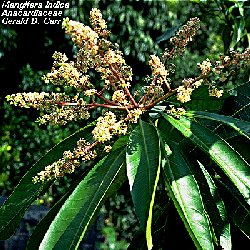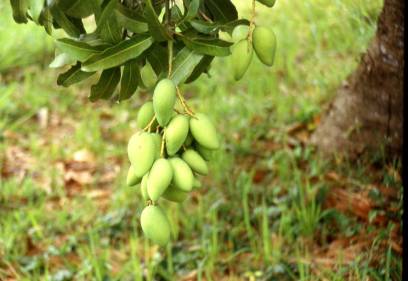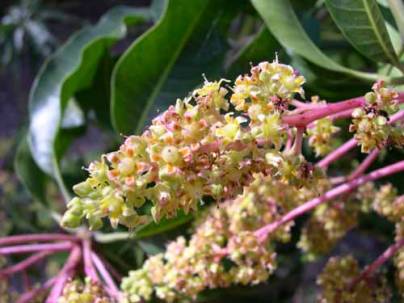
Fig 1 : Mango tree in flowering

Fig 2: Mango Inflorescence

Fig 3 : Fruits in a Bunch

Fig 4 : Mango flowers
| Back | Apple of the Tropics : Mangifera indica L. |
Next |
Suja A |
Family : Anacardiaceae
Genus : Mangifera
Species: indica
The family contains 73 genera and about 600-700 species, distinguished by their resinous bark and caustic oils in leaves, bark, and fruits. Several species, including mango, can cause some form of dermatitis in humans.
Mangifera contains about 30 species, although some authors put the number as high as 69. Up to 15 other species produce edible fruit, including the water mango M. laurina, and M. sylvatica, the wild, forest mango from which M. indica is thought to have descended.
FAO-2002
Top 10 countries |
|
1. India (44%) |
6. Philippines (3%) |
2. China (13%) |
7. Indonesia (3%) |
3. Thailand (6%) |
8. Nigeria (3%) |
4. Mexico (5%) |
9. Brazil (2%) |
5. Pakistan (4%) |
10. Egypt (1%) |
Common Names: Mango, an lo kuo, anbah, manga agaci, manga, mangot fil, mangot, manguier, mamuang, aangga, merpelam, pelem, Maamidi, Aam, Maavini.
Inflorescence : Terminal panicles
Fruit : Drupe
Fig 1 : Mango tree in flowering |
Fig 2: Mango Inflorescence |
Fig 3 : Fruits in a Bunch |
Fig 4 : Mango flowers |
Parts Used : Fruit, seed, leaves, bark, latex
Properties : Anti-asthmatic, Antiseptic, Antiviral, Cardiotonic, Emetic, Expectorant, Hypotensive, Laxative
Plant Chemicals Include : 2-octene, alanine, alpha-phellandrene, alpha-pinene, ambolic-acid, ambonic-acid, arginine, ascorbic-acid, beta-carotene beta-pinene, carotenoids, furfurol, gaba, gallic-acid, gallotannic-acid, geraniol, histidine, isoleucine, isomangiferolic-acid, kaempferol, limonene, linoleic-acid, mangiferic-acid, mangiferine, mangiferol, mangiferolic-acid, myristic-acid, neo-beta-carotene-b, neo-beta-carotene-u, neoxanthophyll, nerol, neryl-acetate, oleic-acid, oxalic-acid, p-coumaric-acid, palmitic-acid, palmitoleic-acid, pantothenic-acid, peroxidase, phenylalanine, phytin, proline, quercetin, xanthophyll
• Young flowers and newly unfolded leaves are said to be edible but could be dangerous to sensitive people. The sap may cause a rash like poison oak.
• Gum from the trunks is eaten in India, and is used for mending pottery.
• Twigs and leaves, used to clean the teeth, are said to be beneficial to the gums,
• Bark is useful for toothaches. The astringent stomachic bark is also used for internal hemorrhages, bronchitis , and catarrh.
• Resin is used for cracked feet, ringworm, and other fungi, syphilis, and to induce sweating.
• Smoke from the burning leaves is believed to cure various throat disorders, from asthma to hiccups.
• Dried flowers are used to treat gleet.
• Green fruits are anticholeric (baked and mixed with sugar and taken internally and also rubbed over the body), antidysmenorrheic, antiscorbutic, astringent, and diaphoretic.
• Roasted green fruits are dissolved in sugar water and taken internally to prevent sunstroke and they may be just rubbed on the body.
• Ripe fruits are diuretic, laxative, and unguent, and the gum is used to treak scabies; the seeds are anthelmintic, antiasthmatic, antimenorrhagic, antidysesnteric, and unguent.
• Seeds, gruel made of the seeds is taken internally for bleeding piles.
Sap which exudes from the stalk close to the base of the fruit is somewhat milky at first, also yellowish-resinous. It becomes pale-yellow and translucent when dried. It contains mangiferen, resinous acid, mangiferic acid, and the resinol, mangiferol. It, like the sap of the trunk and branches and the skin of the unripe fruit, is a potent skin irritant, and capable of blistering the skin of the normal individual.
The leaves contain the glucoside, mangiferine . In India, cows were formerly fed mango leaves to obtain from their urine euxanthic acid which is rich yellow and has been used as a dye. Since continuous intake of the leaves may be fatal, the practice has been outlawed.
When mango trees are in bloom , it is not uncommon for people to suffer itching around the eyes, facial swelling and respiratory difficulty, even though there is no airborne pollen. The few pollen grains are large and they tend to adhere to each other even in dry weather. The stigma is small and not designed to catch windborne pollen. The irritant is the vaporized essential oil of the flowers which contains the sesquiterpene alcohol, mangiferol, and the ketone, mangiferone .
Medicinal Uses:
FDA states mango contains
Water (%) |
80 |
Calories |
63 |
Protein (%) |
0.4 |
Fat (%) |
0.4 |
Carbohydrates (%) |
16 |
Crude Fiber (%) |
1.0 |
Note : This has been compiled from various sources.